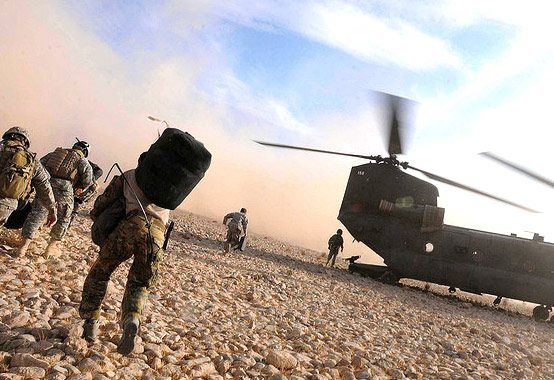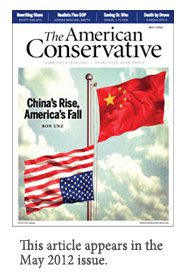How To Leave Afghanistan

It appears that the United States will soon be leaving Afghanistan, and not on its preferred schedule. Early this year the U.S. lost two soldiers in combat with the Taliban and six killed by members of the Afghan armed forces, formally our allies. If we continue to order our troops to work with and trust people who murder them, our Army will start to unravel.
But that is what we must do because it is what our strategy, or what passes for one, requires. That strategy is to continue fighting the Taliban through 2014, then turn the war over to the Afghan government’s army and police. U.S. advisors and trainers would remain, at least those who are not shot by the Afghan soldiers they are advising and training.
This is not a strategy. It is nothing but a hope, an increasingly forlorn one. We hope that somehow an army and a police force with low skills, little loyalty, and a small fraction of the combat power we possess will defeat a Taliban we have not been able to beat. We similarly disguised hope as a strategy in Vietnam.
Is it possible to replace this pseudo-strategy with a real strategy for the Afghan War? Yes. The starting point has to be a strategic goal that is attainable. The most that can now be attained in Afghanistan is a quiet defeat. That was what we got in Iraq, and it would look much the same in Afghanistan. An Afghan government, probably a coalition, would last for a while after we got out. We would leave on what we could claim was our own timetable, more or less. Afghanistan would not be a real state, just as Iraq is not a real state; in both cases, most of the security forces give their loyalty to entities other than the government. But by the time both disintegrate, the American public’s attention will have moved on to other things. That is how quiet defeat works.
Having set a realistic strategic goal, we next must understand what strategy is. Col. John Boyd, America’s greatest military theorist, defined it as a game of connection and isolation. We want to break the Taliban’s vital connections while strengthening our own.
As is widely recognized, the key to both is Pakistan. That country is the Taliban’s enabler. Break that connection, and the Taliban would be greatly weakened. In turn, most observers know that we need to strengthen our own connection to Pakistan. In strategy, geography counts.
What is not recognized is that the Karzai government, with our acquiesence and support, has done the opposite. It has compelled Pakistan to ally with the Taliban. How? By aligning Afghanistan with India.
India is Pakistan’s primary threat. When we permitted Karzai to openly align Afghanistan with India, we took away Pakistan’s strategic depth in a war with India and replaced it with the threat of a second front, an attack from the rear. Pakistan’s only possible counter is to support the Taliban, trusting it, once returned to power in Kabul, to break the Indian alliance and realign with Pakistan. This is the only thing Pakistan can do; it has no other strategic choice.
Washington refuses to understand this because in its hubris the Washington establishment refuses to take any other countries’ interests seriously. In effect it says to the rest of the world, Pakistan included: “Don’t talk to us about your interests. We’re America, which means you are supposed to make our interests the center of your concern.” This goes over as well in Islamabad as it does in Moscow, Cairo, and Beijing.
If we are to have a genuine Afghan strategy, this attitude is the first thing that has to change. Tell Pakistan instead: “We get it. Your problem is India. From now on, your problem is our problem. For starters, we will make sure Kabul breaks with India and becomes your very reliable, indeed subordinate, partner.”
Then we give Karzai an ultimatum: either he does that, openly and unambiguously, or we pull out as fast as we can get out. He can then deal with the Taliban on his own. In the end, he is a puppet and he knows it. The problem is that we have not been pulling the right strings.
With Pakistan’s strategic depth restored and the threat of a second front eliminated, it can then tell an isolated Taliban to swallow the pill labeled “coalition government.” That Afghan government does not have to last forever, just long enough to give us a “decent interval.” That in turn yields us a quiet defeat.
 What of India? Here, we need to ask the ever useful question, “What would Bismarck do?” While India still pretends to gibber at the specter of Pakistan, it knows it is far more powerful than its old rival. India’s real competitor now is China. America’s interests are far more dependent on China than on India, which gives us strong reasons to tilt toward Beijing. Bismarck would have realized that puts us in the driver’s seat. India needs us more than we need India. We can treat New Delhi accordingly.
What of India? Here, we need to ask the ever useful question, “What would Bismarck do?” While India still pretends to gibber at the specter of Pakistan, it knows it is far more powerful than its old rival. India’s real competitor now is China. America’s interests are far more dependent on China than on India, which gives us strong reasons to tilt toward Beijing. Bismarck would have realized that puts us in the driver’s seat. India needs us more than we need India. We can treat New Delhi accordingly.
That, in outline, is a plausible strategy for Afghanistan. Will Washington adopt it? Probably not. Few Washington insiders even know what a strategy is. John Boyd used to say, “Lots of people in Washington talk about strategy. Most of them can spell it. That’s as far as it goes.”
William S. Lind is director of the American Conservative Center for Public Transportation.
Comments